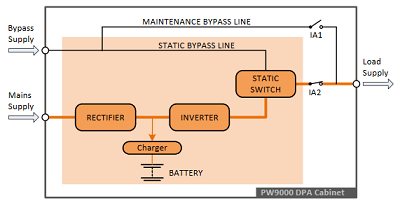KOHLER Uninterruptible Power (UPSs) provide their best protection in on line mode, where they filter power to the critical load. However, under some circumstances running the UPS in offline mode may be acceptable, with the load powered directly from the mains while it’s available.
This bypass option, whether through choice or necessity, calls for a static switch that handles the changeover between the UPS and bypass – and back again – reliably and seamlessly. Below, we look at the static switch and its role within the UPS.

Fig.1: UPS components, showing static switch
Fig.1 shows how the static switch connects the critical load to either conditioned power from the UPS or raw mains from the bypass supply. In some installations, the bypass supply could be provided by an on-site generator. The static switch has two operational states – ‘On UPS’ and ‘On Bypass’.
The function of a static switch in UPS
The static switch’s role relates to the three operational modes for UPS systems; ‘on-line’, ‘off-line’ and ‘line-interactive’. Products such as KUP.’s KOHLER PW 9000DPA can operate in any of these modes.
The Three UPS Operational Modes are:
On-Line UPS Operation
On line operation offers the best protection to the load. The mains supply, when present, is used to feed the rectifier which generates a stable output DC voltage. This is used both to float charge the battery and supply the inverter. If mains is lost through a power blackout, or its quality is compromised, the battery takes over and begins to discharge through the inverter, which continues to support the critical load with well-regulated AC power. This design is often referred to as ‘double-conversion’, due to the two conversion stages, AC-DC and DC-AC.
While the UPS is on line, using either mains or battery power, the static switch is in ‘On UPS’ state, connecting the inverter output to the load. However, if a UPS fault should develop, causing either the voltage or frequency at the inverter output to exceed acceptable levels, or an overload beyond the UPS’s redundancy capacity appears, the static switch changes over without power interruption to ‘Load on Bypass’.
Once the overload is cleared or other problems rectified, the static switch transfers the load back to the inverter output and normal operation continues.
Off-line UPS Operation
Off-line operation is possible for loads that can tolerate short power interruptions or electrical disturbances without damage, especially if there is confidence in the mains supply’s quality and continuity. Off line mode means that during normal operation the static bypass switch is in ‘On Bypass’ mode with the load being fed directly from the bypass supply. The rectifier and charger remain powered to enable battery charging, while the inverter is also enabled and ready on standby.
If the bypass supply fails the static switch will transfer the load to the inverter output – within 3 – 5 ms for the KOHLER PW 9000DPA – and if all mains supplies are missing at the time of transfer, the inverter is supplied by the battery. When supplies return to normal, the static switch automatically transfers the load back to bypass while the battery recharges and the inverter reverts to standby mode.
Line-interactive UPS Operation
Line-interactive systems are variants of off-line types that attempt to improve on off-line UPS performance by providing voltage regulation in the bypass line. Off-line/line-interactive systems are slightly more efficient than on-line configurations due to reduced rectifier and inverter losses, and ‘off-line’ is sometimes referred to as ‘eco-mode’. However, as previously mentioned, off-line operation is really only recommended with loads that can safely tolerate power loss or electrical disturbances.
Conclusion
As static switch operation involves paralleling the inverter and bypass outputs for short periods, synchronisation between the two supplies is important to avoid subjecting the load to power disturbances.
Overall, UPSs should offer flexibility in their operational mode – on-line or off-line – to best suit the requirements and priorities of their load.
Equally, modern UPS systems are seldom single-channel architectures; with modular implementations offering many advantages. However, these installations must be internally synchronised to function successfully, with all modules either on inverter or on bypass. The use of one static switch per module is favoured, to avoid a single point of failure.
Today’s UPSs that use modular technology are flexible and easily scalable while protecting their critical load from many different threat types. Static switches play a key role in assuring this resilient performance.





